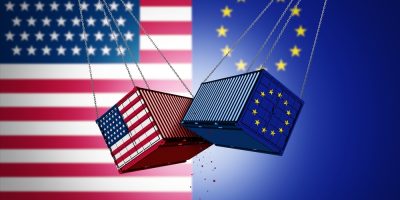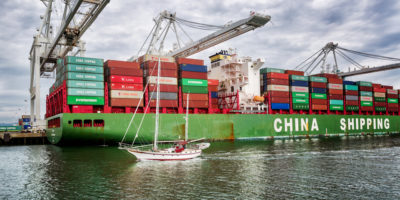-
美国
US Tariffs | Commercial risk management in contracts with international clients and suppliers
14 4 月 2025
- 分销协议
- 税务
The most dangerous mistake one can make after the announcement of the (partial) suspension of U.S. duties for 90 days is to hope that everything will go well and we will return to the pre-April 2 world.
First, because very invasive tariffs remain in place: 10 percent on all countries that trade with the U.S., including the EU, 25 percent on automotive, 25 percent on steel and aluminum, 145 percent on China.
Second, because it is impossible to predict the actions of the U.S. Administration in the short and medium term: it cannot be ruled out that tariffs will remain, increase, change targets or that other factors will intervene to turn the tide in international markets, such as an escalation of the trade war with China.
The 90-day suspension is an opportunity
The U.S.’s temporary suspension of tariffs represents a valuable window that should be used not only as a truce but also as a valuable room for action: 90 days to rehash contracts, renegotiate key clauses, and insert levers of flexibility that can protect business in various future scenarios in the U.S. and other markets.
Today’s exporters cannot afford to “sit back and see what will happen”-it is time to act, and to do so professionally and strategically. Let’s look at a checklist of important points to consider.
What do contracts with customers and suppliers entail?
The first point is to survey agreements with the trade network in the U.S. and other countries that export to the U.S., as well as with upstream suppliers in the supply chain.
Is there a written contract? The worst-case scenario – unfortunately a very frequent one – is when the parties cooperate informally, only based on orders and order confirmations. This leaves undefined not only what happens in the case of imposition of duties, but also a whole range of other points, for example, limits on damages that can be claimed in the case of breach of contract, the duration of the agreement, the applicable law, and how any disputes will be resolved.
Another very problematic scenario is one in which contracts exist, but they are generic and do not include the necessary covenants to manage the risks involved in operating in a highly litigious market such as the U.S., which, moreover, has very high legal costs.
Having done this analysis, the necessary actions can be put in place, prioritizing according to the importance of business relationships and as appropriate:
- Negotiate and conclude a written contract from scratch
- Replace the existing agreement with a complete and correct contract
- Amend and integrate the existing agreement with pacts to manage tariffs and other causes of price fluctuations
Let us dwell on the last scenario, assuming that there is a complete and correct contract but one that does not regulate price and cost fluctuation as a direct or indirect consequence of the introduction of duties.
Contract Addendum
In such cases, the correct course of action is to sign an Addendum to the original contract, specifying which covenants are being waived and which covenants are being added. It is essential that the Addendum be negotiated and signed by persons with the power of representation of the parties and that it be drafted with the help of lawyers who specialize in this field. In addition to including correct clauses, it is necessary to verify that the covenants are valid according to the rules of law applicable to the contract.
Here are some clauses that can be the subject of the Addendum, to be modulated according to the specific case and possible scenarios.
Tariff Cost Sharing
By introducing this covenant, it is provided that in the event that duties are confirmed at [x]% or are reduced or increased within certain established thresholds, the Parties will share the increase equally, or according to other established percentages.
There may also be a ceiling on tariffs beyond which a party has the right to withdraw from the contract or request the suspension of certain orders for a specified period of time, after which it has the right to withdraw.
Price Adjustment
With this covenant, a discount or an increase in the product’s price is agreed upon, as the case may be, in the case of a duty greater than [x]%.
Among the use cases, in addition to that of the company exporting to the U.S. or other intermediate markets, with final destination of the products in the U.S., is that of those who purchase a product subject to import duty and resell it, processed or assembled.
Right to Cancel or Postpone Confirmed Orders
This covenant gives the right to revoke or suspend for a certain period already negotiated orders, as such binding, in case of confirmation or introduction of duties above a certain threshold, for example, if 20% taxation was confirmed for the import of wine from the EU.
The clause can be combined with previous covenants, for example, by stipulating that below the specified threshold, the contracts remain valid, and the parties share the duty or have the right to renegotiate the price.
Supply Forecast Adjustment
With this clause the Parties can modify supply programs already agreed for a specific duration (e.g., 24 months), with continuous sales and purchase obligations at a fixed price or indexable only within certain limits. The aim is to agree on the prerequisites for reshaping supply programs in the short and medium term, which can be very useful for defining the rules that will apply to relationships with key suppliers or customers for possible changes in volumes, delivery times, and prices.
Right to Source from Alternative Suppliers
This covenant serves to be authorized, if necessary, to source alternative suppliers of components or raw materials to those previously authorized in the contract with the end customer, for example, in cases where purchasing from the original suppliers has become too costly or difficult due to duties imposed at import or in previous steps in the supply chain, or other events such as currency or price fluctuation of certain commodities beyond a certain level established in the agreement.
Hardship and Force Majeure
The imposition of duties cannot be invoked as a cause of Force Majeure or hardship, respectively, to excuse contract non-performance or to renegotiate the price, even in cases of very high price increases (such as the 145% duty imposed on Chinese products). This conclusion is almost uniform under the law and jurisprudence of the major countries involved in the tariff war: U.S., China, Canada, Mexico, France and Italy: I refer to this practical guide for a timely examination of what the various rules provide.
If the contract lacks a well drafter Force Majeure and Hardship clause, or contains a generic clause, it is important to get your hands on revising it to expressly state the cases in which a party is entitled to suspend or terminate the contract, how and when to communicate the decision to invoke the exemption, and the consequences on the parties’ contractual obligations. You can go deeper on this topic here.
Conclusion
It is essential to prepare for possible future scenarios regarding duties (confirmed, increased, changed, or decreased) and to determine the consequences on trade relations with foreign clients and suppliers: moving today, at a standstill (or nearly so), allows entrepreneurs to negotiate shared and fair solutions and to avoid, as far as possible, the emergence of tensions and conflicts with the various partners along the international supply chain.
On April 2, 2025, U.S. tariffs toward products from the EU will go into effect.
Given what happened with the tariffs imposed on Canada and Mexico, with a chase of announcements of entry into force and suspensions and new announcements, it is impossible to make even short-term predictions.
One must prepare oneself for the possibility of imposition of duty, which is a foreseeable and anticipated event and, as such, should be regulated in the contract. Failure to do so is likely to be very costly because there are no valid arguments for excusing the non-performance of contracts already concluded by invoking a situation of Force Majeure (which does not exist, because the performance has not become objectively impossible) or of supervening excessive onerousness or hardship: even in the case of increases well over 25 percent, tribunals around the world tend to rule out its invocation).
The caution that can be taken is to negotiate a price update clause, expressly referring, among other factors, to the eventual adoption of tariffs.
A useful clause may be the so-called Escalator or Price Adjustment Clause, by which the right to renegotiate the price is provided in the case of imposing a duty above a certain threshold, for example:
PRICE ADJUSTMENT CLAUSE
Triggering Event
A “Triggering Event” shall be deemed to occur if:
- There is an increase in customs duties or the introduction of new trade barriers not previously contemplated, resulting in an increase in the total price of the goods or services by X% or more.
- Such an increase affects either (i) the Buyer directly or (ii) the Seller due to tariffs imposed on its upstream suppliers, materially impacting the cost of performance.
Trigger Mechanism
In the event of a Triggering Event:
- The affected Party shall notify the other Party in writing within thirty (30) days of the effective date of the customs duty change or the introduction of the new trade barrier.
- The notification must include supporting documentation demonstrating the financial impact of the Triggering Event.
Renegotiation Process
Upon receipt of a valid notification, the Parties shall engage in good-faith negotiations for sixty (60) days to agree on an adjusted price that reflects the increased costs.
Failure to Reach an Agreement
If the Parties fail to reach an agreement on the price adjustment within the prescribed sixty (60) days:
Option 1 – Contract Termination: Either Party shall have the right to terminate the contract by providing written notice to the other Party, without liability for damages, except for obligations already accrued up to the termination date.
Option 2 – Third-Party Arbitrator: The Parties shall appoint an independent third-party arbitrator with expertise in international trade and pricing. The arbitrator shall determine a fair market price, which shall be binding on both Parties. The cost of the arbitrator shall be borne equally by both Parties unless otherwise agreed.
***
Another possible tool as an alternative to the clause just seen is the so-called Cost Sharing clause, for example:
COST SHARING CLAUSE
Triggering Event
A “Triggering Event” shall be deemed to occur if there is an increase in customs duties or the introduction of new trade barriers not previously contemplated, resulting in an increase in the total price of the goods by [X]% or more. Such an increase will be borne by the Buyer by up to [X]%, while higher increases will be shared equally between the seller and buyer.
***
It is appropriate for such clauses to be adapted on a case-by-case basis to best to reflect the scenarios that are expected to affect the price of the products, namely
- imposition of duty on U.S. entry
- imposition of duty on EU entry
but also indirect effects, such as where it is the seller who invokes price renegotiation, for example because the price of the product has increased due to the duty paid by one of its upstream suppliers in the supply chain, in which case it is crucial to identify which products are relevant and to document the increases resulting from the imposition of tariffs.
Summary
Artist Mason Rothschild created a collection of digital images named “MetaBirkins”, each of which depicted a unique image of a blurry faux-fur covered the iconic Hermès bags, and sold them via NFT without any (license) agreement with the French Maison. HERMES brought its trademark action against Rothschild on January 14, 2022.
A Manhattan federal jury of nine persons returned after the trial a verdict stating that Mason Rothschild’s sale of the NFT violated the HERMES’ rights and committed trademark infringement, trademark dilution, and cybersquatting (through the use of the domain name “www.metabirkins.com”) because the US First Amendment protection could not apply in this case and awarded HERMES the following damages: 110.000 US$ as net profit earned by Mason Rothschild and 23.000 US$ because of cybersquatting.
The sale of approx. 100 METABIRKIN NFTs occurred after a broad marketing campaign done by Mason Rothschild on social media.
Rothschild’s defense was that digital images linked to NFT “constitute a form of artistic expression” i.e. a work of art protected under the First Amendment and similar to Andy Wahrhol’s paintings of Campbell’s soup cans. The aim of the defense was to have the “Rogers” legal test (so-called after the case Rogers vs Grimaldi) applied, according to which artists are entitled to use trademarks without permission as long as the work has an artistic value and is not misleading the consumers.
NFTs are digital record (a sort of “digital deed”) of ownership typically recorded in a publicly accessible ledger known as blockchain. Rothschild also commissioned computer engineers to operationalize a “smart contract” for each of the NFTs. A smart contract refers to a computer code that is also stored in the blockchain and that determines the name of each of the NFTs, constrains how they can be sold and transferred, and controls which digital files are associated with each of the NFTs.
The smart contract and the NFT can be owned by two unrelated persons or entities, like in the case here, where Rothschild maintained the ownership of the smart contract but sold the NFT.
“Individuals do not purchase NFTs to own a “digital deed” divorced to any other asset: they buy them precisely so that they can exclusively own the content associated with the NFT” (in this case the digital images of the MetaBirkin”), we can read in the Opinion and Order. The relevant consumers did not distinguish the NFTs offered by Rothschild from the underlying MetaBirkin image associated to the NFT.
The question was whether or not there was a genuine artistic expression or rather an unlawful intent to cash in on an exclusive valuable brand name like HERMES.
Mason Rothschild’s appeal to artistic freedom was not considered grounded since it came out that Rothschild was pursuing a commercial rather than an artistic end, further linking himself to other famous brands: Rothschild remarked that “MetaBirkins NFTs might be the next blue chip”. Insisting that he “was sitting on a gold mine” and referring to himself as “marketing king”, Rothschild “also discussed with his associates further potential future digital projects centered on luxury projects such watch NFTs called “MetaPateks” and linked to the famous Swiss luxury watches Patek Philippe.
TAKE AWAY: This is the first US decision on NFT and IP protection for trademarks.
The debate (i) between the protection of the artistic work and the protection of the trademark or other industrial property rights or (ii) between traditional artistic work and subsequent digital reinterpretation by a third party other than the original author, will lead to other decisions (in Italy, we recall the injunction order issued on 20-7-2022 by the Court of Rome in favour of the Juventus football team against the company Blockeras, producer of NFT associated with collectible digital figurines depicting the footballer Bobo Vieri, without Juventus’ licence or authorisation). This seems to be a similar phenomenon to that which gave rise some 15 years ago to disputes between trademark owners and owners of domain names incorporating those trademarks. For the time being, trademark and IP owners seem to have the upper hand, especially in disputes that seem more commercial than artistic.
For an assessment of the importance and use of NFT and blockchain in association also with IP rights, you can read more here.
Every employer should manage the risk of employee lawsuits. Many companies believe that they treat their workers well and that their employees are happy. As a result, they believe that they are not at risk of a lawsuit. But in my work, I frequently see employment relationships sour and employees surprise management by retaining a lawyer.
Employers should proactively manage this risk instead of hoping lawsuits never come. Defending a business against litigation by a current or former employee takes a lot of time and can be very expensive. It can also be incredibly frustrating to see an employee the company once trusted making false and damaging allegations. But employers can take steps before a dispute arises to reduce the impact of a lawsuit. I discuss eight such steps below.
First, employers should consider purchasing insurance that may cover employee claims. In the United States, this insurance is called Employment Practices Liability (“EPLI”) Insurance. These kinds of insurance policies may pay for a lawyer to defend the company in the event of a lawsuit. They may also pay the employee the amount he or she demands or that a court awards. Although insurance costs money, many companies prefer to pay regular and foreseeable premiums than sudden, steep, and unpredictable legal fees and employee payouts.
Second, employers should implement and enforce sexual harassment policies. Policies like these discourage the type of behavior that can subject a company to liability. But in many jurisdictions, they may also provide a defense to a company in the event an employee sues the company for allowing the harassment to take place.
Third, employers should seriously examine disparities in pay and job roles. If the highest paid employees at a company are largely male and the lowest paid employees are largely female, then an employee may claim that the employer engages in sex discrimination. Similarly, if the executives of a company are largely white but its blue-collar workers are largely people of color, an employee may allege that the company engages in racial discrimination. Rather than litigate these issues, a company should investigate whether those disparities exist in its own workplace and address them if they do.
Fourth, employers should consider whether they want employment disputes to go to arbitration instead of to court. Employers can largely determine this by including an arbitration clause in the offer letters they send to employees upon hiring them. Arbitration has some advantages: it tends to move quicker, it is private, it has the reputation for being a friendly forum for employers, and it tends to cost less. But it also has some downsides: it does not permit appeals on the merits of the dispute and it can cost more than litigation depending on the kind of case.
Fifth, any time an employee discloses that he or she has a health issue, the company should immediately consider how to accommodate that issue. Many employers may disregard the disclosure of a health issue if it does not seem important to the employee’s job. But if the employee later believes that the employer penalized him or her because of the health issue, the employee may claim discrimination. Before that happens, an employer should work with an employee to make sure the health issue does not impede job performance.
Sixth, employers should ensure they make consistent decisions. If an employer allows one employee to work from home, other employees may want the same treatment. And if an employer lays one employee off, she may wonder why another employee did not meet the same fate. Employers may reduce the risk of a lawsuit by setting firm policies and abiding by them.
Seventh, employers should frequently consult a lawyer they trust when employment issues arise. Spending a few hundred dollars to speaking to a lawyer for an hour before firing an employee or before responding to an employee complaint can help an employer avoid a lawsuit that may cost tens or even hundreds of thousands of dollars.
And finally, employers should consider settling disputes with employees, even if they are meritless. No company wants an employee to take advantage of them. But lawsuits are often more expensive and a hassle than the cost of a settlement. Spending a lot of money on defense, even if successful, may be more expensive than just compromising and paying the employee a fraction of what they demand.
Summary
Courts around the world issue judgments against defendants who hold assets in the United States. For example, some judgments may be against American corporations that do business abroad or local citizens who maintain bank accounts with American banks. Once a plaintiff prevails in the foreign lawsuit, she may have to initiate a proceeding in the United States to use that judgment to actually collect the defendant’s American assets. But this process, which is called domestication, has some specific rules that may be helpful to know before moving forward.
Why should you read this post about issues that may arise in domesticating foreign judgments in the United States?
- You already read my post about enforcing judgments issued by one court in the United States in a different court elsewhere in the country, but you want more judgment enforcement content.
- Cross-border disputes feel more exotic and fancy than local people who are mad at each other.
- The word domesticating makes you think that lawyers can take a wild judgment and teach it to live in a house with people.
Is the Judgment Debtor Subject to Personal Jurisdiction?
Pursuant to the Uniform Foreign Money Judgments Recognition Act, American courts may seek proof that a foreign judgment is legitimate before enforcing it. One issue courts often examine is whether the judgment debtor was subject to personal jurisdiction in the foreign country. If the court holds that the defendant was not subject to jurisdiction abroad, the court may not enforce the judgment in the United States. To determine whether personal jurisdiction existed abroad, courts may examine both the foreign jurisdiction’s law and American law, as the court did in this case.
Additionally, American courts may also require that the judgment debtor also be subject to personal jurisdiction in the United States. Following a New York appellate court decision, some lawyers argued that the process of domesticating a judgment in the United States was a merely “ministerial function” and not a full lawsuit that required personal jurisdiction over the judgment debtor. But the New York appellate court clarified in another decision that personal jurisdiction is required over judgment debtors when domesticating foreign judgments.
The Separate Entity Rule
Litigants frequently seek to domesticate foreign judgments in the United States because defendants often have accounts at American banks. The United States may also seem like an attractive place to domesticate a judgment because nearly every major bank in the world has an office or does business in the United States. But just because a bank is subject to jurisdiction in the United States does not mean that courts will definitely enforce foreign judgments against the assets they hold.
Instead, jurisdictions like New York apply the “Separate Entity Rule.” This rule treats each branch of a financial institution as if it were a separate entity. This means that, for example, a New York judgment can only be used to collect assets from a Swiss bank that are held at a New York branch of that bank. The judgment cannot, however, be used to collect assets held at Swiss branches.
According to New York’s highest court, the purpose of the Separate Entity Rule is to encourage banks to do business in a jurisdiction without fear that they are subjecting all of their international assets to local judgments. And it is to prevent other jurisdictions from exposing American banks to foreign judgments in return. It also makes it easier for bank branches to comply with only one country’s laws, avoiding conflicts between different countries’ laws or judgments, and to perform searches of only local assets and not assets worldwide.
Because of this rule, judgment creditors from outside of the United States should only domesticate judgments in the same place where the judgment debtors’ assets are, not just where their banks are located.
Bringing Assets into the Jurisdiction
Although litigants often need to domesticate a judgment to collect assets in another jurisdiction, there are some instances where a court can order a party to move assets into the jurisdiction.
This issue arose in a prominent case in New York. In that case, the court held that a defendant that is subject to personal jurisdiction in New York can be ordered to bring physical property it possesses into New York to satisfy a judgment. It held in a later case that this does not conflict with the Separate Entity Rule because that rule only applies to bank accounts at bank branches.
This principle may be helpful for litigants who want to domesticate a judgment against a defendant who is subject to personal jurisdiction in the United States, but who has physical property outside of the country. This may provide the American legal system’s procedures for judgment collection while also enabling the judgment creditor to collect foreign property.
Takeways:
- plaintiffs should ensure that they have personal jurisdiction over defendants not just under the laws of the jurisdiction where they bring suit, but also under the laws of the jurisdiction where they intend on enforcing judgments;
- plaintiffs should ensure that the jurisdictions in which they enforce judgments have the power to actually collect defendants’ assets, since some may not do so under rules like the Separate Entity Rule.
The COVID-19 pandemic’s dramatic disruption of the legal and business landscape has included a steep drop in overall M&A activity in Q1 2020. Much of this decrease has been due to decreased target valuations, tighter access by buyers to liquidity, and perhaps above all underlying uncertainty as to the crisis’s duration.
For pending transactions, whether the buyer can walk away from the deal (or seek a purchase price reduction) by invoking a material adverse change (MAC) or material adverse effect (MAE) clause – or another clause in the purchase agreement – due to COVID-19 has become a question of increasing relevance. MAC/MAE clauses typically allow a buyer to terminate an acquisition agreement if a MAC or MAE occurs between signing and closing.
Actual litigated cases in this area have been few and far between, as under longstanding Delaware case law[1], buyer has the burden of proving MAC or MAE, irrespective of who initiates the lawsuit. And the standard of proof is high – a buyer must show that the effects of the intervening event are sufficiently large and long lasting as compared to an equivalent period of the prior year. A short-term or immaterial deviation will not suffice. In fact, Delaware courts have only once found a MAC, in the December 2018 case Akorn, Inc. v. Fresenius Kabi AG.
And yet, since the onset of the COVID-19 pandemic, numerous widely reported COVID-19 related M&A litigations have been initiated with the Delaware Court of Chancery. These include:
- Bed, Bath & Beyond suing 1-800-Flowers (Del. Ch. April 1, 2020) to complete its acquisition of Perosnalizationmall.com (purchaser sought an extension in closing, without citing specifically the contractual basis for the request);
- Level 4 Yoga, franchisee of CorePower Yoga, suing CorePower Yoga (Del. Ch. Apr 2, 2020) to compel CorePower Yoga to purchase of Level 4 Yoga studios (after CorePower Yoga took the position that studio closings resulting from COVID-19 stay-at-home orders violated the ordinary course covenant);
- Oberman, Tivoli & Pickert suing Cast & Crew (Del. Ch. Apr 6, 2020), an industry competitor, to complete its purchase of Oberman’s subsidiary (Cast & Crew maintained it was not obligated to close based on alleged insufficiencies in financial data provided in diligence);
- SP VS Buyer LP v. L Brands, Inc. (Del. Ch. Apr 22, 2020), in which buyer sought a declaratory judgment in its favor on termination); and
- L Brands, Inc. v. SP VS Buyer L.P., Sycamore Partners III, L.P., and Sycamore Partners III-A, L.P (Del. Ch. Apr 23), in which seller instead seeks declaratory judgment in its favor on buyer obligation to close.
Such cases, typically signed up at an early stage of the pandemic, are likely to increase. Delaware M&A-MAC-related jurisprudence suggests that buyers seeking to cite MAC in asserting their positions should expect an uphill fight, given buyer’s high burden of proof. Indeed, Delaware courts’ sole finding of a MAC in Akorn was based on rather extreme facts: target’s (Akorn’s) business deteriorated significantly (40% and 20% drops in profit and equity value, respectively), measured over a full year. And quite material to the Court’s decision was the likely devastating effect on Akorn’s business resulting from Akorn’s deceptive conduct vis-à-vis the FDA.
By contrast, cases before and after Akorn, courts have not found a MAC/MAE, including in the 2019 case Channel Medsystems, Inc. v. Bos. Sci. Corp. There, Boston Scientific Corporation (BSC) agreed to purchase Channel Medsystems, Inc., an early stage medical device company. The sale was conditioned on Channel receiving FDA approval for its sole product, Cerene. In late December 2017, Channel discovered that falsified information from reports by its Vice President of Quality (as part of a scheme to steal over $2 million from Channel) was included in Channel’s FDA submissions. BSC terminated the merger agreement in May 2018, asserting that Channel’s false representations and warranties constituted a MAC.
The court disagreed. While Channel and Akron both involved a fraud element, Chanel successfully resubmitted its FDA application, such that the fraudulent behavior – the court found – would not cause the FDA to reject the Cerene device. BSC also failed to show sufficiently large or long-lasting effects on Channel’s financial position. Channel thus reaffirmed the high bar under pre-Akron Delaware jurisprudence for courts to find a MAC/MAE (See e.g. In re IBP, Inc. S’holders Litig., 789 A.2d 14 (Del. Ch. 2001); Frontier Oil Corp. v. Holly Corp., 2005 WL 1039027 (Del. Ch. Apr. 29, 2005); Hexion Specialty Chemicals v. Huntsman Corp., 965 A.2d 715 (Del. Ch. 2008)).
Applied to COVID-19, buyers may have challenges in invoking MAC/MAE clauses under their purchase agreements.
First, it may simply be premature at this juncture for a buyer to show the type of longer-term effects that have been required under Delaware jurisprudence. The long-term effects of COVID-19 itself are unclear. Of course, as weeks turn into months and longer, this may change.
A second challenge is certain carve-outs typically included in MAC/MAE clauses. Notably, it is typical for these clauses to include exceptions for general economic and financial conditions generally affecting a target’s industry, unless a buyer can demonstrate that they have disproportionately affected the target.
A buyer may be able to point to other clauses in a purchase agreement in seeking to walk away from the deal. Of note is the ordinary course covenant that applies to the period between signing and closing. By definition, most targets are unable to carry out business during the COVID-19 crisis consistent with past practice. It is unclear whether courts will allow for a literal reading of these clauses, or interpret them taking into account the broader risk allocation regime as evidenced by the MAC or MAE clause in the agreement, and in doing so reject a buyer’s position.
For unsigned deals, there may be some early lessons for practitioners as they prepare draft purchase agreements. On buyer walk-away rights, buyers will want to ensure that the MAE/MAC definition includes express reference to “pandemics” and “epidemics”, if not to “COVID-19” itself. Conversely, Sellers may wish to seek to loosen ordinary course covenant language, such as by including express exceptions for actions required by the MAC or MAE and otherwise ensure that they comply with all obligations under their control. Buyers will also want to pay close attention to how COVID-19 affects other aspects of the purchase agreement, including seeking more robust representations and warranties on the impact of COVID-19 on the target’s business.
[1] Although the discussion of this based Delaware law, caselaw in other U.S. jurisdictions often is consistent Delaware.
美国的艺术家人数众多。至少是移民目的上定义的“艺术家”。事实上,O1是最常见的签证之一,也被称为艺术家签证。更确切的说,O1签证不是专门为艺术家提供的,而是为所有那些在某些领域表现出杰出能力的人,例如艺术。
O-1签证适用于以下条件的人:1)在科学,教育,商业和体育方面的具有杰出能力;2)在艺术领域具有杰出能力。此类别不仅限于纯艺,表演艺术和视觉艺术,还包括任何创造性活动或努力领域。摄影师,设计师,建筑师,作家甚至理发师和厨师都被视为移民目的的艺术家,并有资格获得O-1签证;或3)电影或电视行业具有杰出成就。
三个类别之间的区别在于证明的标准。最具挑战性的案例是那些在科学,教育,商业和体育方面具有非凡能力的人,因为他们只为那些已经上升到这些领域最顶层的人保留,占很小比例。而对于那些试图在电影或电视行业中取得非凡成就的人来说,证明标准就没有那么严格,要求O-1签证受益人是杰出的,表明受益人是知名的、优秀的。最后,艺术中具有非凡能力的人的类别是最容易证明的,因为一定程度的区别就足够了。为了表明卓越,受益人需要提供其在特定领域的非凡能力的文件证据。总而言之,艺术类别是最广泛和最容易证明的。因此,可以得出结论,美国,至少出于移民目的,是一个艺术家友好的国家。
以下是需要向美国公民与移民服务局(USCIS)提交的不同签证证明类别之间的进一步差异解释。更具体地说,第一类由具有非凡科学,教育,商业和体育能力的人组成,并按照O-1A分组,与其他两个人不同(艺术方面的非凡能力和电影或电视行业),按O-1B分组。
要获得O-1A签证,受益人必须证明他或她已经通过以下方式上升到他或她的领域的最顶层:
- 有证据表明受益人已获得国际公认的重大奖项,如诺贝尔奖;
- 或至少有(3)以下三项证据:
- 在领域获得国家或国际公认的奖项
- 该领域公认的国家或国际专家认可的, 取得杰出成就的领域协会的成员资格
- 在专业或主要商业出版物,报纸或其他主要媒体上发布关于受益人和受益人在该领域的工作的材料
- 与该领域具有重要意义的原创科学,学术或商业相关的贡献
- 在专业期刊或其他主要媒体中分类的学术文章的作者
- 高薪合同或其他服务高报酬的可靠证据证明
- 参加该领域分类的专题讨论,或单独作为个人评审在相同或专业领域的工作
- 具有关键或必要能力,就业于对具有卓越声誉的组织和机构
另一方面,要获得O-1B签证,受益人必须证明: · 受益人已获得或被提名为特定领域的重要国家或国际奖项或奖项的证据,例如奥斯卡奖,艾美奖,格莱美奖或导演协会奖,· 下列至少(3)项的证据:
- 在具有杰出声誉的制作或活动中作为并将作为主要参与者,证据如重要评论,广告,宣传发布,出版物,合同或认可证明
- 成就获得国家或者国际认可,例如在主要报刊,商业出版物,杂志或其他地方发表的有关受益人或受益人直接发表的重要评论
- 在一个知名机构作为或即将作为一个主导的,主演的,重要角色,证据如报刊文章,贸易期刊,出版物或证明信
- 在商业上,或专业评论上取得成功,例如在改领域的评分,评级或地位,票房收入,收视率,以及被主要商业期刊,报刊,出版物报道
- 来自组织,评论家,政府机构或其他知名领域专家对受益人成就的重要认可,证明信应清楚指出作者对收益人成就的权威、专业认知
- 合同或其他可靠证据所示,高薪或其他相关的服务的高报酬
值得注意的是,在O-1B中有两个具有不同证明标准的子类别:对于运动和电视行业的人们来说更为严格(优秀),对于艺术领域(区别)证明更容易。
关于所需的证据,O-1案件需要通过出版物,获奖记录和推荐信来证明和提供证据。显然,有一些证据明确的案例更容易,但有些案例需要通过受益人和专业律师之间的团队合作来“建立”。
在O-1申请中,申请人需要是美国雇主或美国代理人。第一个需要是专门雇用受益人的个人或企业。就业合同或至少是口头协议条款的摘要可以提供足够的证据来证明雇主/雇员的关系。另一方面,美国代理人可以作为代理人在相关领域和业务中,并且可以提交请求而不承诺专门雇用受益人。在这些情况下,将需要提供计划或建议事件的行程。
O-1签证可以在受益人参加活动期间授予,最长可达三年,如果活动延长,可延长1年。也就是说,除非…… 在O-1签证持有人满足成为美国永久居民的要求之前。 O-1签证确实提供了一个机会来获得备受追捧和令人垂涎的“绿卡”。
The 2017 Tax Cuts and Jobs Act (the “TCJA”), signed into law by President Trump on December 22, 2017, introduces sweeping changes in U.S. tax law, affecting businesses of all kinds. This Practice Note focuses on a few key provisions of the TCJA particularly relevant to non-U.S. manufacturing corporations with U.S. distribution subsidiaries. These changes in U.S. tax law may impact these companies operate now, as well as future plans for entering the U.S. market.
Federal Corporate Income Tax Rate
- Change: Most significantly, the US federal corporate tax rate has permanently been reduced from 35% to 21%. In addition, the corporate alternative minimum tax (which applied when higher than the regular corporate tax) has been repealed.
- Comment: The reduction of the headline U.S. federal corporate tax rate to 21%, which is a lower rate than in many of the home countries of non-U.S. corporations, will obviously benefit non-U.S. manufacturers with existing U.S. subsidiaries, and may influence those who sell directly into the U.S. (g., through independent distributors) to consider forming US subsidiaries and expanding their U.S. presence.
Interest Deductions
- Change: Under the TCJA, net business interest deductions are generally limited to 30% of “adjusted taxable income,” which is essentially EBITDA (taxable income plus depreciation and amortization deductions) for years 2018-2021 and EBIT (taxable income without adding back depreciation/amortization). Disallowed interest expense is carried forward indefinitely. Before the TCJA, interest was generally deductible when paid or accrued, subject to numerous limitations, including debt/equity ratios and taxable income. U.S. corporations – other than small businesses (average annual gross receipts under $25 million, on an affiliated group basis) – are subject to these limitations.
- Comment: The TCJA’s limitation on interest deductions are designed to protect the U.S. tax base. As a result, non-U.S. manufacturers with existing U.S. subsidiaries, and those planning to establish U.S. subsidiaries, may decide to reduce or limit the amount of debt in their U.S. subsidiaries.
Base Erosion and Anti-Abuse Tax (BEAT)
- Change: Under the TCJA, large U.S. corporations that are part of multinational groups are potentially subject to a new BEAT tax, which is essentially a minimum tax applicable to corporations that seek to reduce their US taxes by claiming large deductions for “base erosion payments” to non-US affiliates. The targeted deductions include royalties, interest and depreciation. However, and of particular significance to non-U.S. manufacturers, the version of the BEAT as finally enacted does not treat inventory costs (cost of goods sold) as base erosion payments. The BEAT generally applies to U.S. corporations that are part of multinational groups with average annual gross receipts of $500 million over the prior three-year period. The tax rate is five percent in 2018, 10% through 2025, and 12.5% thereafter.
- Comment: U.S. corporations with foreign headquarters that may be subject to BEAT may wish to revisit current practices as to purchase and sale of product, license arrangements and the provisions of back-office and other services between foreign parent and U.S. subsidiary.
Net Operating Losses
Net operating losses (NOL) from prior years generally can no longer be carried back to claim refunds. A U.S. company may use NOL carryforwards to offset only up to 80% of its taxable income (with unused NOLs carried forward into future years). Note that NOLs arising in tax years that began on or before December 31, 2017, will remain subject to the prior two-year carryback and twenty-year carryforward rule until their expiration and will also continue to be available to offset 100% of taxable income. As a result, a corporation with pre-TCJA NOLs may be viewed as more valuable than corporations with newer NOLs.
Foreign-derived Intangible Income (FDII)
- Change: The TCJA implements a new tax regime that provides a lower 13.125% U.S. federal income tax rate (rather than the new standard 21% rate) on “foreign-derived intangible income” for U.S. corporations. The special tax rate is effected by granting a 37.5% deduction for a C corporation’s foreign-derived intangible income. Foreign-derived intangible income is, generally, a portion of a C corporation’s income in excess of a threshold return derived from services performed for persons not located in the United States and from sales or licensure of property to non-U.S. persons for consumption outside the United States. The 37.5% deduction is temporary, and for tax years beginning after December 31, 2025, drops to 21.875%, resulting in a U.S. federal income tax rate of 16.406% (rather than the standard 21% rate) on foreign-derived intangible income for those years.
- Comment: FDII should encourage non-U.S. manufacturers to hold intellectual property (IP) in the U.S. and exporting from the U.S, rather than, for example, through a tax-haven entity that licenses the IP to a U.S. subsidiary. This may be particularly of interest to non-U.S. technology-based companies that seek to migrate to the U.S., as their principal market (whether for talent, sales or financing).
Of course, this Practice Note only provides a broad summary of certain highly technical provisions of the TCJA that we think are particularly relevant to non-U.S. manufacturing companies with U.S. distribution subsidiaries. Because they are new (and unclear in certain respects), many open questions remain on which we await further guidance. Please contact me in case you have any questions regarding these matters.
写信给 Roberto
US TARIFFS | Contractual clauses for managing price increases
14 3 月 2025
-
欧洲
-
美国
- 分销协议
- 税务
The most dangerous mistake one can make after the announcement of the (partial) suspension of U.S. duties for 90 days is to hope that everything will go well and we will return to the pre-April 2 world.
First, because very invasive tariffs remain in place: 10 percent on all countries that trade with the U.S., including the EU, 25 percent on automotive, 25 percent on steel and aluminum, 145 percent on China.
Second, because it is impossible to predict the actions of the U.S. Administration in the short and medium term: it cannot be ruled out that tariffs will remain, increase, change targets or that other factors will intervene to turn the tide in international markets, such as an escalation of the trade war with China.
The 90-day suspension is an opportunity
The U.S.’s temporary suspension of tariffs represents a valuable window that should be used not only as a truce but also as a valuable room for action: 90 days to rehash contracts, renegotiate key clauses, and insert levers of flexibility that can protect business in various future scenarios in the U.S. and other markets.
Today’s exporters cannot afford to “sit back and see what will happen”-it is time to act, and to do so professionally and strategically. Let’s look at a checklist of important points to consider.
What do contracts with customers and suppliers entail?
The first point is to survey agreements with the trade network in the U.S. and other countries that export to the U.S., as well as with upstream suppliers in the supply chain.
Is there a written contract? The worst-case scenario – unfortunately a very frequent one – is when the parties cooperate informally, only based on orders and order confirmations. This leaves undefined not only what happens in the case of imposition of duties, but also a whole range of other points, for example, limits on damages that can be claimed in the case of breach of contract, the duration of the agreement, the applicable law, and how any disputes will be resolved.
Another very problematic scenario is one in which contracts exist, but they are generic and do not include the necessary covenants to manage the risks involved in operating in a highly litigious market such as the U.S., which, moreover, has very high legal costs.
Having done this analysis, the necessary actions can be put in place, prioritizing according to the importance of business relationships and as appropriate:
- Negotiate and conclude a written contract from scratch
- Replace the existing agreement with a complete and correct contract
- Amend and integrate the existing agreement with pacts to manage tariffs and other causes of price fluctuations
Let us dwell on the last scenario, assuming that there is a complete and correct contract but one that does not regulate price and cost fluctuation as a direct or indirect consequence of the introduction of duties.
Contract Addendum
In such cases, the correct course of action is to sign an Addendum to the original contract, specifying which covenants are being waived and which covenants are being added. It is essential that the Addendum be negotiated and signed by persons with the power of representation of the parties and that it be drafted with the help of lawyers who specialize in this field. In addition to including correct clauses, it is necessary to verify that the covenants are valid according to the rules of law applicable to the contract.
Here are some clauses that can be the subject of the Addendum, to be modulated according to the specific case and possible scenarios.
Tariff Cost Sharing
By introducing this covenant, it is provided that in the event that duties are confirmed at [x]% or are reduced or increased within certain established thresholds, the Parties will share the increase equally, or according to other established percentages.
There may also be a ceiling on tariffs beyond which a party has the right to withdraw from the contract or request the suspension of certain orders for a specified period of time, after which it has the right to withdraw.
Price Adjustment
With this covenant, a discount or an increase in the product’s price is agreed upon, as the case may be, in the case of a duty greater than [x]%.
Among the use cases, in addition to that of the company exporting to the U.S. or other intermediate markets, with final destination of the products in the U.S., is that of those who purchase a product subject to import duty and resell it, processed or assembled.
Right to Cancel or Postpone Confirmed Orders
This covenant gives the right to revoke or suspend for a certain period already negotiated orders, as such binding, in case of confirmation or introduction of duties above a certain threshold, for example, if 20% taxation was confirmed for the import of wine from the EU.
The clause can be combined with previous covenants, for example, by stipulating that below the specified threshold, the contracts remain valid, and the parties share the duty or have the right to renegotiate the price.
Supply Forecast Adjustment
With this clause the Parties can modify supply programs already agreed for a specific duration (e.g., 24 months), with continuous sales and purchase obligations at a fixed price or indexable only within certain limits. The aim is to agree on the prerequisites for reshaping supply programs in the short and medium term, which can be very useful for defining the rules that will apply to relationships with key suppliers or customers for possible changes in volumes, delivery times, and prices.
Right to Source from Alternative Suppliers
This covenant serves to be authorized, if necessary, to source alternative suppliers of components or raw materials to those previously authorized in the contract with the end customer, for example, in cases where purchasing from the original suppliers has become too costly or difficult due to duties imposed at import or in previous steps in the supply chain, or other events such as currency or price fluctuation of certain commodities beyond a certain level established in the agreement.
Hardship and Force Majeure
The imposition of duties cannot be invoked as a cause of Force Majeure or hardship, respectively, to excuse contract non-performance or to renegotiate the price, even in cases of very high price increases (such as the 145% duty imposed on Chinese products). This conclusion is almost uniform under the law and jurisprudence of the major countries involved in the tariff war: U.S., China, Canada, Mexico, France and Italy: I refer to this practical guide for a timely examination of what the various rules provide.
If the contract lacks a well drafter Force Majeure and Hardship clause, or contains a generic clause, it is important to get your hands on revising it to expressly state the cases in which a party is entitled to suspend or terminate the contract, how and when to communicate the decision to invoke the exemption, and the consequences on the parties’ contractual obligations. You can go deeper on this topic here.
Conclusion
It is essential to prepare for possible future scenarios regarding duties (confirmed, increased, changed, or decreased) and to determine the consequences on trade relations with foreign clients and suppliers: moving today, at a standstill (or nearly so), allows entrepreneurs to negotiate shared and fair solutions and to avoid, as far as possible, the emergence of tensions and conflicts with the various partners along the international supply chain.
On April 2, 2025, U.S. tariffs toward products from the EU will go into effect.
Given what happened with the tariffs imposed on Canada and Mexico, with a chase of announcements of entry into force and suspensions and new announcements, it is impossible to make even short-term predictions.
One must prepare oneself for the possibility of imposition of duty, which is a foreseeable and anticipated event and, as such, should be regulated in the contract. Failure to do so is likely to be very costly because there are no valid arguments for excusing the non-performance of contracts already concluded by invoking a situation of Force Majeure (which does not exist, because the performance has not become objectively impossible) or of supervening excessive onerousness or hardship: even in the case of increases well over 25 percent, tribunals around the world tend to rule out its invocation).
The caution that can be taken is to negotiate a price update clause, expressly referring, among other factors, to the eventual adoption of tariffs.
A useful clause may be the so-called Escalator or Price Adjustment Clause, by which the right to renegotiate the price is provided in the case of imposing a duty above a certain threshold, for example:
PRICE ADJUSTMENT CLAUSE
Triggering Event
A “Triggering Event” shall be deemed to occur if:
- There is an increase in customs duties or the introduction of new trade barriers not previously contemplated, resulting in an increase in the total price of the goods or services by X% or more.
- Such an increase affects either (i) the Buyer directly or (ii) the Seller due to tariffs imposed on its upstream suppliers, materially impacting the cost of performance.
Trigger Mechanism
In the event of a Triggering Event:
- The affected Party shall notify the other Party in writing within thirty (30) days of the effective date of the customs duty change or the introduction of the new trade barrier.
- The notification must include supporting documentation demonstrating the financial impact of the Triggering Event.
Renegotiation Process
Upon receipt of a valid notification, the Parties shall engage in good-faith negotiations for sixty (60) days to agree on an adjusted price that reflects the increased costs.
Failure to Reach an Agreement
If the Parties fail to reach an agreement on the price adjustment within the prescribed sixty (60) days:
Option 1 – Contract Termination: Either Party shall have the right to terminate the contract by providing written notice to the other Party, without liability for damages, except for obligations already accrued up to the termination date.
Option 2 – Third-Party Arbitrator: The Parties shall appoint an independent third-party arbitrator with expertise in international trade and pricing. The arbitrator shall determine a fair market price, which shall be binding on both Parties. The cost of the arbitrator shall be borne equally by both Parties unless otherwise agreed.
***
Another possible tool as an alternative to the clause just seen is the so-called Cost Sharing clause, for example:
COST SHARING CLAUSE
Triggering Event
A “Triggering Event” shall be deemed to occur if there is an increase in customs duties or the introduction of new trade barriers not previously contemplated, resulting in an increase in the total price of the goods by [X]% or more. Such an increase will be borne by the Buyer by up to [X]%, while higher increases will be shared equally between the seller and buyer.
***
It is appropriate for such clauses to be adapted on a case-by-case basis to best to reflect the scenarios that are expected to affect the price of the products, namely
- imposition of duty on U.S. entry
- imposition of duty on EU entry
but also indirect effects, such as where it is the seller who invokes price renegotiation, for example because the price of the product has increased due to the duty paid by one of its upstream suppliers in the supply chain, in which case it is crucial to identify which products are relevant and to document the increases resulting from the imposition of tariffs.
Summary
Artist Mason Rothschild created a collection of digital images named “MetaBirkins”, each of which depicted a unique image of a blurry faux-fur covered the iconic Hermès bags, and sold them via NFT without any (license) agreement with the French Maison. HERMES brought its trademark action against Rothschild on January 14, 2022.
A Manhattan federal jury of nine persons returned after the trial a verdict stating that Mason Rothschild’s sale of the NFT violated the HERMES’ rights and committed trademark infringement, trademark dilution, and cybersquatting (through the use of the domain name “www.metabirkins.com”) because the US First Amendment protection could not apply in this case and awarded HERMES the following damages: 110.000 US$ as net profit earned by Mason Rothschild and 23.000 US$ because of cybersquatting.
The sale of approx. 100 METABIRKIN NFTs occurred after a broad marketing campaign done by Mason Rothschild on social media.
Rothschild’s defense was that digital images linked to NFT “constitute a form of artistic expression” i.e. a work of art protected under the First Amendment and similar to Andy Wahrhol’s paintings of Campbell’s soup cans. The aim of the defense was to have the “Rogers” legal test (so-called after the case Rogers vs Grimaldi) applied, according to which artists are entitled to use trademarks without permission as long as the work has an artistic value and is not misleading the consumers.
NFTs are digital record (a sort of “digital deed”) of ownership typically recorded in a publicly accessible ledger known as blockchain. Rothschild also commissioned computer engineers to operationalize a “smart contract” for each of the NFTs. A smart contract refers to a computer code that is also stored in the blockchain and that determines the name of each of the NFTs, constrains how they can be sold and transferred, and controls which digital files are associated with each of the NFTs.
The smart contract and the NFT can be owned by two unrelated persons or entities, like in the case here, where Rothschild maintained the ownership of the smart contract but sold the NFT.
“Individuals do not purchase NFTs to own a “digital deed” divorced to any other asset: they buy them precisely so that they can exclusively own the content associated with the NFT” (in this case the digital images of the MetaBirkin”), we can read in the Opinion and Order. The relevant consumers did not distinguish the NFTs offered by Rothschild from the underlying MetaBirkin image associated to the NFT.
The question was whether or not there was a genuine artistic expression or rather an unlawful intent to cash in on an exclusive valuable brand name like HERMES.
Mason Rothschild’s appeal to artistic freedom was not considered grounded since it came out that Rothschild was pursuing a commercial rather than an artistic end, further linking himself to other famous brands: Rothschild remarked that “MetaBirkins NFTs might be the next blue chip”. Insisting that he “was sitting on a gold mine” and referring to himself as “marketing king”, Rothschild “also discussed with his associates further potential future digital projects centered on luxury projects such watch NFTs called “MetaPateks” and linked to the famous Swiss luxury watches Patek Philippe.
TAKE AWAY: This is the first US decision on NFT and IP protection for trademarks.
The debate (i) between the protection of the artistic work and the protection of the trademark or other industrial property rights or (ii) between traditional artistic work and subsequent digital reinterpretation by a third party other than the original author, will lead to other decisions (in Italy, we recall the injunction order issued on 20-7-2022 by the Court of Rome in favour of the Juventus football team against the company Blockeras, producer of NFT associated with collectible digital figurines depicting the footballer Bobo Vieri, without Juventus’ licence or authorisation). This seems to be a similar phenomenon to that which gave rise some 15 years ago to disputes between trademark owners and owners of domain names incorporating those trademarks. For the time being, trademark and IP owners seem to have the upper hand, especially in disputes that seem more commercial than artistic.
For an assessment of the importance and use of NFT and blockchain in association also with IP rights, you can read more here.
Every employer should manage the risk of employee lawsuits. Many companies believe that they treat their workers well and that their employees are happy. As a result, they believe that they are not at risk of a lawsuit. But in my work, I frequently see employment relationships sour and employees surprise management by retaining a lawyer.
Employers should proactively manage this risk instead of hoping lawsuits never come. Defending a business against litigation by a current or former employee takes a lot of time and can be very expensive. It can also be incredibly frustrating to see an employee the company once trusted making false and damaging allegations. But employers can take steps before a dispute arises to reduce the impact of a lawsuit. I discuss eight such steps below.
First, employers should consider purchasing insurance that may cover employee claims. In the United States, this insurance is called Employment Practices Liability (“EPLI”) Insurance. These kinds of insurance policies may pay for a lawyer to defend the company in the event of a lawsuit. They may also pay the employee the amount he or she demands or that a court awards. Although insurance costs money, many companies prefer to pay regular and foreseeable premiums than sudden, steep, and unpredictable legal fees and employee payouts.
Second, employers should implement and enforce sexual harassment policies. Policies like these discourage the type of behavior that can subject a company to liability. But in many jurisdictions, they may also provide a defense to a company in the event an employee sues the company for allowing the harassment to take place.
Third, employers should seriously examine disparities in pay and job roles. If the highest paid employees at a company are largely male and the lowest paid employees are largely female, then an employee may claim that the employer engages in sex discrimination. Similarly, if the executives of a company are largely white but its blue-collar workers are largely people of color, an employee may allege that the company engages in racial discrimination. Rather than litigate these issues, a company should investigate whether those disparities exist in its own workplace and address them if they do.
Fourth, employers should consider whether they want employment disputes to go to arbitration instead of to court. Employers can largely determine this by including an arbitration clause in the offer letters they send to employees upon hiring them. Arbitration has some advantages: it tends to move quicker, it is private, it has the reputation for being a friendly forum for employers, and it tends to cost less. But it also has some downsides: it does not permit appeals on the merits of the dispute and it can cost more than litigation depending on the kind of case.
Fifth, any time an employee discloses that he or she has a health issue, the company should immediately consider how to accommodate that issue. Many employers may disregard the disclosure of a health issue if it does not seem important to the employee’s job. But if the employee later believes that the employer penalized him or her because of the health issue, the employee may claim discrimination. Before that happens, an employer should work with an employee to make sure the health issue does not impede job performance.
Sixth, employers should ensure they make consistent decisions. If an employer allows one employee to work from home, other employees may want the same treatment. And if an employer lays one employee off, she may wonder why another employee did not meet the same fate. Employers may reduce the risk of a lawsuit by setting firm policies and abiding by them.
Seventh, employers should frequently consult a lawyer they trust when employment issues arise. Spending a few hundred dollars to speaking to a lawyer for an hour before firing an employee or before responding to an employee complaint can help an employer avoid a lawsuit that may cost tens or even hundreds of thousands of dollars.
And finally, employers should consider settling disputes with employees, even if they are meritless. No company wants an employee to take advantage of them. But lawsuits are often more expensive and a hassle than the cost of a settlement. Spending a lot of money on defense, even if successful, may be more expensive than just compromising and paying the employee a fraction of what they demand.
Summary
Courts around the world issue judgments against defendants who hold assets in the United States. For example, some judgments may be against American corporations that do business abroad or local citizens who maintain bank accounts with American banks. Once a plaintiff prevails in the foreign lawsuit, she may have to initiate a proceeding in the United States to use that judgment to actually collect the defendant’s American assets. But this process, which is called domestication, has some specific rules that may be helpful to know before moving forward.
Why should you read this post about issues that may arise in domesticating foreign judgments in the United States?
- You already read my post about enforcing judgments issued by one court in the United States in a different court elsewhere in the country, but you want more judgment enforcement content.
- Cross-border disputes feel more exotic and fancy than local people who are mad at each other.
- The word domesticating makes you think that lawyers can take a wild judgment and teach it to live in a house with people.
Is the Judgment Debtor Subject to Personal Jurisdiction?
Pursuant to the Uniform Foreign Money Judgments Recognition Act, American courts may seek proof that a foreign judgment is legitimate before enforcing it. One issue courts often examine is whether the judgment debtor was subject to personal jurisdiction in the foreign country. If the court holds that the defendant was not subject to jurisdiction abroad, the court may not enforce the judgment in the United States. To determine whether personal jurisdiction existed abroad, courts may examine both the foreign jurisdiction’s law and American law, as the court did in this case.
Additionally, American courts may also require that the judgment debtor also be subject to personal jurisdiction in the United States. Following a New York appellate court decision, some lawyers argued that the process of domesticating a judgment in the United States was a merely “ministerial function” and not a full lawsuit that required personal jurisdiction over the judgment debtor. But the New York appellate court clarified in another decision that personal jurisdiction is required over judgment debtors when domesticating foreign judgments.
The Separate Entity Rule
Litigants frequently seek to domesticate foreign judgments in the United States because defendants often have accounts at American banks. The United States may also seem like an attractive place to domesticate a judgment because nearly every major bank in the world has an office or does business in the United States. But just because a bank is subject to jurisdiction in the United States does not mean that courts will definitely enforce foreign judgments against the assets they hold.
Instead, jurisdictions like New York apply the “Separate Entity Rule.” This rule treats each branch of a financial institution as if it were a separate entity. This means that, for example, a New York judgment can only be used to collect assets from a Swiss bank that are held at a New York branch of that bank. The judgment cannot, however, be used to collect assets held at Swiss branches.
According to New York’s highest court, the purpose of the Separate Entity Rule is to encourage banks to do business in a jurisdiction without fear that they are subjecting all of their international assets to local judgments. And it is to prevent other jurisdictions from exposing American banks to foreign judgments in return. It also makes it easier for bank branches to comply with only one country’s laws, avoiding conflicts between different countries’ laws or judgments, and to perform searches of only local assets and not assets worldwide.
Because of this rule, judgment creditors from outside of the United States should only domesticate judgments in the same place where the judgment debtors’ assets are, not just where their banks are located.
Bringing Assets into the Jurisdiction
Although litigants often need to domesticate a judgment to collect assets in another jurisdiction, there are some instances where a court can order a party to move assets into the jurisdiction.
This issue arose in a prominent case in New York. In that case, the court held that a defendant that is subject to personal jurisdiction in New York can be ordered to bring physical property it possesses into New York to satisfy a judgment. It held in a later case that this does not conflict with the Separate Entity Rule because that rule only applies to bank accounts at bank branches.
This principle may be helpful for litigants who want to domesticate a judgment against a defendant who is subject to personal jurisdiction in the United States, but who has physical property outside of the country. This may provide the American legal system’s procedures for judgment collection while also enabling the judgment creditor to collect foreign property.
Takeways:
- plaintiffs should ensure that they have personal jurisdiction over defendants not just under the laws of the jurisdiction where they bring suit, but also under the laws of the jurisdiction where they intend on enforcing judgments;
- plaintiffs should ensure that the jurisdictions in which they enforce judgments have the power to actually collect defendants’ assets, since some may not do so under rules like the Separate Entity Rule.
The COVID-19 pandemic’s dramatic disruption of the legal and business landscape has included a steep drop in overall M&A activity in Q1 2020. Much of this decrease has been due to decreased target valuations, tighter access by buyers to liquidity, and perhaps above all underlying uncertainty as to the crisis’s duration.
For pending transactions, whether the buyer can walk away from the deal (or seek a purchase price reduction) by invoking a material adverse change (MAC) or material adverse effect (MAE) clause – or another clause in the purchase agreement – due to COVID-19 has become a question of increasing relevance. MAC/MAE clauses typically allow a buyer to terminate an acquisition agreement if a MAC or MAE occurs between signing and closing.
Actual litigated cases in this area have been few and far between, as under longstanding Delaware case law[1], buyer has the burden of proving MAC or MAE, irrespective of who initiates the lawsuit. And the standard of proof is high – a buyer must show that the effects of the intervening event are sufficiently large and long lasting as compared to an equivalent period of the prior year. A short-term or immaterial deviation will not suffice. In fact, Delaware courts have only once found a MAC, in the December 2018 case Akorn, Inc. v. Fresenius Kabi AG.
And yet, since the onset of the COVID-19 pandemic, numerous widely reported COVID-19 related M&A litigations have been initiated with the Delaware Court of Chancery. These include:
- Bed, Bath & Beyond suing 1-800-Flowers (Del. Ch. April 1, 2020) to complete its acquisition of Perosnalizationmall.com (purchaser sought an extension in closing, without citing specifically the contractual basis for the request);
- Level 4 Yoga, franchisee of CorePower Yoga, suing CorePower Yoga (Del. Ch. Apr 2, 2020) to compel CorePower Yoga to purchase of Level 4 Yoga studios (after CorePower Yoga took the position that studio closings resulting from COVID-19 stay-at-home orders violated the ordinary course covenant);
- Oberman, Tivoli & Pickert suing Cast & Crew (Del. Ch. Apr 6, 2020), an industry competitor, to complete its purchase of Oberman’s subsidiary (Cast & Crew maintained it was not obligated to close based on alleged insufficiencies in financial data provided in diligence);
- SP VS Buyer LP v. L Brands, Inc. (Del. Ch. Apr 22, 2020), in which buyer sought a declaratory judgment in its favor on termination); and
- L Brands, Inc. v. SP VS Buyer L.P., Sycamore Partners III, L.P., and Sycamore Partners III-A, L.P (Del. Ch. Apr 23), in which seller instead seeks declaratory judgment in its favor on buyer obligation to close.
Such cases, typically signed up at an early stage of the pandemic, are likely to increase. Delaware M&A-MAC-related jurisprudence suggests that buyers seeking to cite MAC in asserting their positions should expect an uphill fight, given buyer’s high burden of proof. Indeed, Delaware courts’ sole finding of a MAC in Akorn was based on rather extreme facts: target’s (Akorn’s) business deteriorated significantly (40% and 20% drops in profit and equity value, respectively), measured over a full year. And quite material to the Court’s decision was the likely devastating effect on Akorn’s business resulting from Akorn’s deceptive conduct vis-à-vis the FDA.
By contrast, cases before and after Akorn, courts have not found a MAC/MAE, including in the 2019 case Channel Medsystems, Inc. v. Bos. Sci. Corp. There, Boston Scientific Corporation (BSC) agreed to purchase Channel Medsystems, Inc., an early stage medical device company. The sale was conditioned on Channel receiving FDA approval for its sole product, Cerene. In late December 2017, Channel discovered that falsified information from reports by its Vice President of Quality (as part of a scheme to steal over $2 million from Channel) was included in Channel’s FDA submissions. BSC terminated the merger agreement in May 2018, asserting that Channel’s false representations and warranties constituted a MAC.
The court disagreed. While Channel and Akron both involved a fraud element, Chanel successfully resubmitted its FDA application, such that the fraudulent behavior – the court found – would not cause the FDA to reject the Cerene device. BSC also failed to show sufficiently large or long-lasting effects on Channel’s financial position. Channel thus reaffirmed the high bar under pre-Akron Delaware jurisprudence for courts to find a MAC/MAE (See e.g. In re IBP, Inc. S’holders Litig., 789 A.2d 14 (Del. Ch. 2001); Frontier Oil Corp. v. Holly Corp., 2005 WL 1039027 (Del. Ch. Apr. 29, 2005); Hexion Specialty Chemicals v. Huntsman Corp., 965 A.2d 715 (Del. Ch. 2008)).
Applied to COVID-19, buyers may have challenges in invoking MAC/MAE clauses under their purchase agreements.
First, it may simply be premature at this juncture for a buyer to show the type of longer-term effects that have been required under Delaware jurisprudence. The long-term effects of COVID-19 itself are unclear. Of course, as weeks turn into months and longer, this may change.
A second challenge is certain carve-outs typically included in MAC/MAE clauses. Notably, it is typical for these clauses to include exceptions for general economic and financial conditions generally affecting a target’s industry, unless a buyer can demonstrate that they have disproportionately affected the target.
A buyer may be able to point to other clauses in a purchase agreement in seeking to walk away from the deal. Of note is the ordinary course covenant that applies to the period between signing and closing. By definition, most targets are unable to carry out business during the COVID-19 crisis consistent with past practice. It is unclear whether courts will allow for a literal reading of these clauses, or interpret them taking into account the broader risk allocation regime as evidenced by the MAC or MAE clause in the agreement, and in doing so reject a buyer’s position.
For unsigned deals, there may be some early lessons for practitioners as they prepare draft purchase agreements. On buyer walk-away rights, buyers will want to ensure that the MAE/MAC definition includes express reference to “pandemics” and “epidemics”, if not to “COVID-19” itself. Conversely, Sellers may wish to seek to loosen ordinary course covenant language, such as by including express exceptions for actions required by the MAC or MAE and otherwise ensure that they comply with all obligations under their control. Buyers will also want to pay close attention to how COVID-19 affects other aspects of the purchase agreement, including seeking more robust representations and warranties on the impact of COVID-19 on the target’s business.
[1] Although the discussion of this based Delaware law, caselaw in other U.S. jurisdictions often is consistent Delaware.
美国的艺术家人数众多。至少是移民目的上定义的“艺术家”。事实上,O1是最常见的签证之一,也被称为艺术家签证。更确切的说,O1签证不是专门为艺术家提供的,而是为所有那些在某些领域表现出杰出能力的人,例如艺术。
O-1签证适用于以下条件的人:1)在科学,教育,商业和体育方面的具有杰出能力;2)在艺术领域具有杰出能力。此类别不仅限于纯艺,表演艺术和视觉艺术,还包括任何创造性活动或努力领域。摄影师,设计师,建筑师,作家甚至理发师和厨师都被视为移民目的的艺术家,并有资格获得O-1签证;或3)电影或电视行业具有杰出成就。
三个类别之间的区别在于证明的标准。最具挑战性的案例是那些在科学,教育,商业和体育方面具有非凡能力的人,因为他们只为那些已经上升到这些领域最顶层的人保留,占很小比例。而对于那些试图在电影或电视行业中取得非凡成就的人来说,证明标准就没有那么严格,要求O-1签证受益人是杰出的,表明受益人是知名的、优秀的。最后,艺术中具有非凡能力的人的类别是最容易证明的,因为一定程度的区别就足够了。为了表明卓越,受益人需要提供其在特定领域的非凡能力的文件证据。总而言之,艺术类别是最广泛和最容易证明的。因此,可以得出结论,美国,至少出于移民目的,是一个艺术家友好的国家。
以下是需要向美国公民与移民服务局(USCIS)提交的不同签证证明类别之间的进一步差异解释。更具体地说,第一类由具有非凡科学,教育,商业和体育能力的人组成,并按照O-1A分组,与其他两个人不同(艺术方面的非凡能力和电影或电视行业),按O-1B分组。
要获得O-1A签证,受益人必须证明他或她已经通过以下方式上升到他或她的领域的最顶层:
- 有证据表明受益人已获得国际公认的重大奖项,如诺贝尔奖;
- 或至少有(3)以下三项证据:
- 在领域获得国家或国际公认的奖项
- 该领域公认的国家或国际专家认可的, 取得杰出成就的领域协会的成员资格
- 在专业或主要商业出版物,报纸或其他主要媒体上发布关于受益人和受益人在该领域的工作的材料
- 与该领域具有重要意义的原创科学,学术或商业相关的贡献
- 在专业期刊或其他主要媒体中分类的学术文章的作者
- 高薪合同或其他服务高报酬的可靠证据证明
- 参加该领域分类的专题讨论,或单独作为个人评审在相同或专业领域的工作
- 具有关键或必要能力,就业于对具有卓越声誉的组织和机构
另一方面,要获得O-1B签证,受益人必须证明: · 受益人已获得或被提名为特定领域的重要国家或国际奖项或奖项的证据,例如奥斯卡奖,艾美奖,格莱美奖或导演协会奖,· 下列至少(3)项的证据:
- 在具有杰出声誉的制作或活动中作为并将作为主要参与者,证据如重要评论,广告,宣传发布,出版物,合同或认可证明
- 成就获得国家或者国际认可,例如在主要报刊,商业出版物,杂志或其他地方发表的有关受益人或受益人直接发表的重要评论
- 在一个知名机构作为或即将作为一个主导的,主演的,重要角色,证据如报刊文章,贸易期刊,出版物或证明信
- 在商业上,或专业评论上取得成功,例如在改领域的评分,评级或地位,票房收入,收视率,以及被主要商业期刊,报刊,出版物报道
- 来自组织,评论家,政府机构或其他知名领域专家对受益人成就的重要认可,证明信应清楚指出作者对收益人成就的权威、专业认知
- 合同或其他可靠证据所示,高薪或其他相关的服务的高报酬
值得注意的是,在O-1B中有两个具有不同证明标准的子类别:对于运动和电视行业的人们来说更为严格(优秀),对于艺术领域(区别)证明更容易。
关于所需的证据,O-1案件需要通过出版物,获奖记录和推荐信来证明和提供证据。显然,有一些证据明确的案例更容易,但有些案例需要通过受益人和专业律师之间的团队合作来“建立”。
在O-1申请中,申请人需要是美国雇主或美国代理人。第一个需要是专门雇用受益人的个人或企业。就业合同或至少是口头协议条款的摘要可以提供足够的证据来证明雇主/雇员的关系。另一方面,美国代理人可以作为代理人在相关领域和业务中,并且可以提交请求而不承诺专门雇用受益人。在这些情况下,将需要提供计划或建议事件的行程。
O-1签证可以在受益人参加活动期间授予,最长可达三年,如果活动延长,可延长1年。也就是说,除非…… 在O-1签证持有人满足成为美国永久居民的要求之前。 O-1签证确实提供了一个机会来获得备受追捧和令人垂涎的“绿卡”。
The 2017 Tax Cuts and Jobs Act (the “TCJA”), signed into law by President Trump on December 22, 2017, introduces sweeping changes in U.S. tax law, affecting businesses of all kinds. This Practice Note focuses on a few key provisions of the TCJA particularly relevant to non-U.S. manufacturing corporations with U.S. distribution subsidiaries. These changes in U.S. tax law may impact these companies operate now, as well as future plans for entering the U.S. market.
Federal Corporate Income Tax Rate
- Change: Most significantly, the US federal corporate tax rate has permanently been reduced from 35% to 21%. In addition, the corporate alternative minimum tax (which applied when higher than the regular corporate tax) has been repealed.
- Comment: The reduction of the headline U.S. federal corporate tax rate to 21%, which is a lower rate than in many of the home countries of non-U.S. corporations, will obviously benefit non-U.S. manufacturers with existing U.S. subsidiaries, and may influence those who sell directly into the U.S. (g., through independent distributors) to consider forming US subsidiaries and expanding their U.S. presence.
Interest Deductions
- Change: Under the TCJA, net business interest deductions are generally limited to 30% of “adjusted taxable income,” which is essentially EBITDA (taxable income plus depreciation and amortization deductions) for years 2018-2021 and EBIT (taxable income without adding back depreciation/amortization). Disallowed interest expense is carried forward indefinitely. Before the TCJA, interest was generally deductible when paid or accrued, subject to numerous limitations, including debt/equity ratios and taxable income. U.S. corporations – other than small businesses (average annual gross receipts under $25 million, on an affiliated group basis) – are subject to these limitations.
- Comment: The TCJA’s limitation on interest deductions are designed to protect the U.S. tax base. As a result, non-U.S. manufacturers with existing U.S. subsidiaries, and those planning to establish U.S. subsidiaries, may decide to reduce or limit the amount of debt in their U.S. subsidiaries.
Base Erosion and Anti-Abuse Tax (BEAT)
- Change: Under the TCJA, large U.S. corporations that are part of multinational groups are potentially subject to a new BEAT tax, which is essentially a minimum tax applicable to corporations that seek to reduce their US taxes by claiming large deductions for “base erosion payments” to non-US affiliates. The targeted deductions include royalties, interest and depreciation. However, and of particular significance to non-U.S. manufacturers, the version of the BEAT as finally enacted does not treat inventory costs (cost of goods sold) as base erosion payments. The BEAT generally applies to U.S. corporations that are part of multinational groups with average annual gross receipts of $500 million over the prior three-year period. The tax rate is five percent in 2018, 10% through 2025, and 12.5% thereafter.
- Comment: U.S. corporations with foreign headquarters that may be subject to BEAT may wish to revisit current practices as to purchase and sale of product, license arrangements and the provisions of back-office and other services between foreign parent and U.S. subsidiary.
Net Operating Losses
Net operating losses (NOL) from prior years generally can no longer be carried back to claim refunds. A U.S. company may use NOL carryforwards to offset only up to 80% of its taxable income (with unused NOLs carried forward into future years). Note that NOLs arising in tax years that began on or before December 31, 2017, will remain subject to the prior two-year carryback and twenty-year carryforward rule until their expiration and will also continue to be available to offset 100% of taxable income. As a result, a corporation with pre-TCJA NOLs may be viewed as more valuable than corporations with newer NOLs.
Foreign-derived Intangible Income (FDII)
- Change: The TCJA implements a new tax regime that provides a lower 13.125% U.S. federal income tax rate (rather than the new standard 21% rate) on “foreign-derived intangible income” for U.S. corporations. The special tax rate is effected by granting a 37.5% deduction for a C corporation’s foreign-derived intangible income. Foreign-derived intangible income is, generally, a portion of a C corporation’s income in excess of a threshold return derived from services performed for persons not located in the United States and from sales or licensure of property to non-U.S. persons for consumption outside the United States. The 37.5% deduction is temporary, and for tax years beginning after December 31, 2025, drops to 21.875%, resulting in a U.S. federal income tax rate of 16.406% (rather than the standard 21% rate) on foreign-derived intangible income for those years.
- Comment: FDII should encourage non-U.S. manufacturers to hold intellectual property (IP) in the U.S. and exporting from the U.S, rather than, for example, through a tax-haven entity that licenses the IP to a U.S. subsidiary. This may be particularly of interest to non-U.S. technology-based companies that seek to migrate to the U.S., as their principal market (whether for talent, sales or financing).
Of course, this Practice Note only provides a broad summary of certain highly technical provisions of the TCJA that we think are particularly relevant to non-U.S. manufacturing companies with U.S. distribution subsidiaries. Because they are new (and unclear in certain respects), many open questions remain on which we await further guidance. Please contact me in case you have any questions regarding these matters.

























